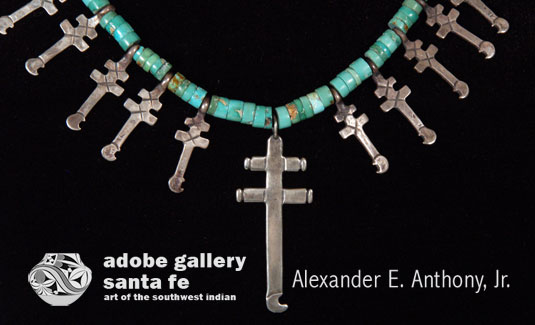Heart of the Dragonfly Necklace with Old Turquoise Beads [SOLD]
+ Add to my watchlist Forward to Friend
- Category: Necklaces
- Origin: KEWA, Santo Domingo Pueblo
- Medium: Turquoise, Coin Silver
- Size: 27” long
- Item # C4104K SOLD

Pueblo stories and myths serve a similar function in Pueblo culture as Greek and Roman myths do in Western European society. Stories are enjoyable, but also are serious ways of passing down important beliefs and value lessons to the younger members of a culture group. One of the best-known stories of Zuni Pueblo is that of the dragonfly. In that story a boy and his baby sister are left behind by villagers who leave after a poor harvest caused by the people’s disrespect for the Corn Maidens. The boy makes a toy dragonfly for his frightened sister, which comes to life and helps the children gain the blessings of the Corn Maidens. It is a story that emphasizes the importance of gratitude and respect of the blessings of nature. A symbol of summer rains, the dragonfly represents the abundance of life.
The origin of the dragonfly shape, or cross, with one or two horizontal bars on a vertical line, certainly predates the arrival of the Spanish and has always been an important symbol in Southwestern culture. Cross or dragonfly forms appear on prehistoric pottery and basketry as well as jewelry. Since the Pueblo people were already accustomed to using the cross design they easily adapted the use of Christian design in silver Southwest Indian Jewelry and pottery. This was probably not a sign of their acceptance of the priest’s theology, but rather a continuation of use of an old and revered image.
This cross necklace features twenty small double bar crosses and one large one. Each has a heart at the bottom of each cross or dragonfly. They were strung along with hand cut and drilled turquoise beads. The turquoise ranges in color from a light sky blue to dark green. The crosses were fashioned from Mexican peso coins. Examination of a few of the smaller crosses reveals the letters P, E and O. It appears that Mexican peso coins were hammered out flat and crosses were formed in that manner. Some of the coins’ edges retained letters from the word PESO.
The crosses look to have been made during the 1940s and placed on the necklace with turquoise beads that date from the very early part of the 20th Century. Most cross necklaces are made with silver beads. This one, strung with old turquoise, is quite unique.
Condition: This Heart of the Dragonfly Necklace with Old Turquoise Beads is in very good condition.
Provenance: From a gentleman in Colorado
Recommended Reading:
- Navajo and Pueblo Silversmiths by John Adair
- Heart of the Dragonfly: Historical Development of the Cross Necklaces of the Pueblo and Navajo Peoples by Allison Bird

- Category: Necklaces
- Origin: KEWA, Santo Domingo Pueblo
- Medium: Turquoise, Coin Silver
- Size: 27” long
- Item # C4104K SOLD



